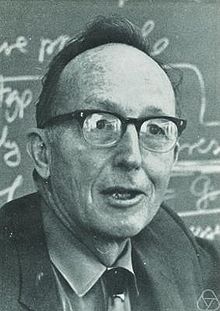Saunders Mac Lane
Saunders Mac Lane (born August 4, 1909 in Taftville , Connecticut , † April 14, 2005 in San Francisco , California ) was an American mathematician . Together with Samuel Eilenberg, he is considered to be the founder of category theory .
Life
Mac Lane's father, a clergyman, died in 1924. Mac Lane then moved in with his grandparents and graduated from high school in 1926 . Mac Lane studied at Yale from 1926 to 1930 . After his bachelor's degree in 1930 he received a one-year research grant at the University of Chicago with a master's degree in 1931. Here he met Eliakim Hastings Moore , on whose advice he went to Göttingen in 1931 for a doctorate , the then center of mathematical research.
On July 19, 1933, he submitted his dissertation entitled Abbreviated Evidence in Logical Calculus and defended it in the Rigorosum on May 26, 1934 against Hermann Weyl and Paul Bernays . Due to the political situation in Germany, Mac Lane left Göttingen shortly afterwards and went back to America. From 1933 to 1934 he was on a fellowship at Yale University . He was a Pierce Instructor at Harvard University from 1934 to 1936 , an instructor at Cornell University in 1936/37 and an instructor at the University of Chicago in 1937/38, before he accepted a position as assistant professor at Harvard in 1938 , where he then became a professor. During the Second World War Mac Lane taught and researched in applied mathematics at Columbia University in New York , where he was director of the Applied Mathematics Group in 1944/45. He was appointed to a chair in Chicago in 1947. From 1963 he was Distinguished Service Professor there . In 1982 he became Professor Emeritus.
In 1947/48 and 1972/73 he was a Guggenheim Fellow at the ETH Zurich and at Columbia University. In 1958 he was visiting professor at the University of Heidelberg and 1960 at the University of Frankfurt, 1969 Fulbright Lecturer at the Australian National University in Canberra and 1969 visiting professor at Tulane University .
He had been married to Osa Skotting since 1986 and had two daughters.
plant
In 1941 he published A Survey of Modern Algebra with Garrett Birkhoff , which quickly became the standard textbook for algebra.
From 1943 he worked with Samuel Eilenberg in the field of topology and especially cohomology , and with this he introduced the Eilenberg-MacLane spaces . In 1945 they laid the foundation of the category theory with General Theory of Natural Equivalences (in Trans. Amer. Math. Soc. , 58, 1945) .
Honors and memberships
- 1941 Chauvenet Prize
- 1975 Distinguished Service Award from the Mathematical Association of America
- 1976 Corresponding member of the Heidelberg Academy of Sciences
- 1982/83 Humboldt Research Award as US Senior Scientist
- 1986: Leroy P. Steele Prize for Lifetime Achievement from the American Mathematical Society
- 1989 National Medal of Science
He has received multiple honorary doctorates (including Harvard - an honorary MA, Yale, University of Pennsylvania, Glasgow).
MacLane was since 1949 a member of the National Academy of Sciences , of which he was Vice President from 1973 to 1977, the Mathematical Association of America (Vice President 1948 to 1950, President 1951 to 1952), the American Philosophical Society (Vice President 1968 to 1971), the American Academy of Arts and Sciences , on whose council he served from 1981 to 1985. From 1946 to 1948 he was Vice President and from 1973 to 1974 President of the American Mathematical Society.
1954 to 1958 he was on the Council (Executive Committee) of the International Mathematical Union . 1974 to 1980 he was on the National Science Board of the USA and 1959 to 1962 and 1969 to 1972 on the council of the National Academy of Sciences.
Works
- Homology , Springer Basic Teachings of Mathematical Sciences Volume 114 (1967)
- with Garrett Birkhoff: A Survey of Modern Algebra Macmillan, New York 1977, ISBN 0-02-310070-2 .
- Mathematics Form and Function . Springer, New York 1986, ISBN 0-387-96217-4 .
- Categories for the Working Mathematician . Springer, New York 1998, ISBN 0-387-98403-8 .
- with Ieke Moerdijk Sheaves in geometry and logic. A first introduction to topos theory , Universitext, Springer-Verlag, 1992, 1994
literature
- Saunders MacLane: Concepts and Categories in Perspective , in AMS History of Mathematics, Vol. 1, online here
- MacLane: Mathematics in Göttingen under the Nazis , messages DMV 1996, No. 2, p. 13.
- Saunders MacLane: a mathematical autobiography , AK Peters 2004
- Donald J. Albers, GL Alexanderson, Constance Reid : More Mathematical People - Contemporary Conversations , Academic Press 1994
Web links
- Literature by and about Saunders Mac Lane in the catalog of the German National Library
- Works by and about Saunders Mac Lane in the German Digital Library
- John J. O'Connor, Edmund F. Robertson : Saunders Mac Lane. In: MacTutor History of Mathematics archive .
- Saunders Mac Lane in the Mathematics Genealogy Project (English)
- Mac Lane's description of what happened in Göttingen during the Nazi era (PDF file; 133 kB)
- Pictures of Mac Lane from 1984 to 1999
- Biography Miriam Becker Mazur with reference to scholarship at Yale University
Individual evidence
- ↑ American Men and Women of Science , Thomson Gale 2004 gives Norwich, Connecticut
- ↑ He reports on his time in Germany in Mathematics at Göttingen under the Nazis , Notices of the American Mathematical Society, Vol. 42, 1995 pp. 1134–1138
- ^ Members of the American Academy. Listed by election year, 1900-1949 ( PDF ). Retrieved October 8, 2015
| personal data | |
|---|---|
| SURNAME | Mac Lane, Saunders |
| BRIEF DESCRIPTION | American mathematician, co-founder of category theory |
| DATE OF BIRTH | 4th August 1909 |
| PLACE OF BIRTH | Taftville , Connecticut |
| DATE OF DEATH | April 14, 2005 |
| Place of death | San Francisco , California |
